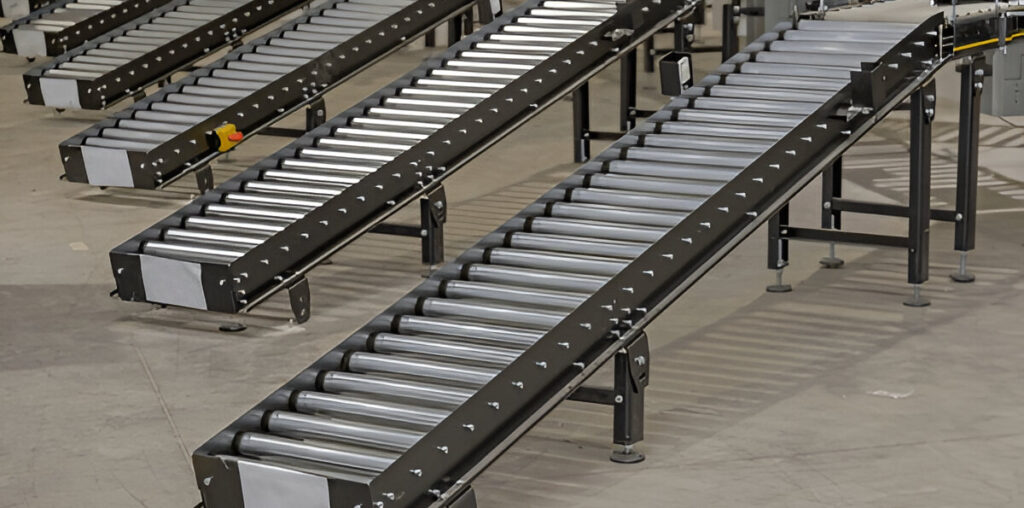Have you ever wondered how Australian warehouses manage to move heavy pallets around without relying on powered systems? Or why are some conveyor setups more efficient than others in handling large volumes of goods? If these questions sound familiar, you’re in the right place. Here, we’ll explore everything you need to know about gravity conveyor rollers, from their benefits in handling heavy loads to the vital role they play in production lines and distribution centers nationwide.
Gravity conveyor rollers are a fantastic option when you need a simple yet effective way to transport items of substantial weight. Rather than relying on motors, they rely on gravity and a controlled decline to shift goods with minimal operator input. In this blog post, we’ll touch on the key factors to consider—like roller diameter, load capacity, and roller material—while also discussing maintenance tips and best practices.
Why Gravity Conveyor Rollers Matter
Gravity conveyor systems are built around a simple concept. They use a framework that supports multiple rollers, allowing goods to flow from one end to the other using only the force of gravity. Because they don’t rely on powered motors, these conveyor systems typically have fewer components, lowering the chances of mechanical failure. Plus, they’re often much easier to install. For businesses in Australia, especially those handling varying item sizes, this setup provides a versatile approach that can be scaled or adapted as needs evolve.
Another crucial aspect is their adaptability. These systems can be customized based on floor layout and available space. Some operations prefer straight conveyor lanes for efficiency, while others add curves or junctions for more complex routes. Gravity conveyor rollers can be combined with other systems, like belt conveyors, to form a more comprehensive network. This flexibility reduces the hassle of reorganizing workflows when your production line changes, or your warehouse layout requires tweaks.
Advantages for Heavy Load Handling
When handling heavyweight items, choices like forklift trucks or powered conveyor systems may come to mind. However, gravity conveyor rollers remain a top choice thanks to their simplicity and cost-effectiveness. They reduce the need for constant operator intervention, which can be especially beneficial in busy warehouses. Because the rollers distribute weight evenly, they can manage loads that might otherwise strain motorized systems.
This approach can also help diminish energy usage. By relying on gravity rather than power, businesses can cut down on electricity costs. Over time, those savings add up, making gravity rollers a budget-friendly option. For companies shipping or receiving heavy goods regularly, the longevity and durability of these rollers become invaluable. Most are built using robust materials like steel, ensuring they last longer even under demanding conditions.
Key Factors to Consider
Choosing the right roller often starts with load capacity. If your goods are extremely heavy, going for a roller with insufficient strength could lead to disastrous failures. Durability is another critical component. The material, whether steel, aluminum, or plastic, should align with your warehousing needs. Steel is a great all-rounder, especially for heavy loads, while plastic might be suitable for lightweight products. Ensure bearings are robust enough to cope with daily wear, especially if your warehouse operates multiple shifts.
It’s also essential to think about the typical conditions your rollers will face. Do you have a dusty environment that might clog moving parts? Or perhaps a damp setting that could cause rusting? Make sure you pick corrosion-resistant materials if you anticipate exposure to moisture. You can also opt for coatings like zinc plating to extend roller life. Ultimately, a balanced approach that accounts for weight, durability, and environmental factors will guide you toward the perfect match.
Roller Diameter and Strength Options
A larger roller diameter naturally distributes weight over a greater surface area, often translating to better support for heavy items. Smaller diameters might be enough for moderate loads, but you risk rapid wear if you underestimate your needs. On top of diameter, the roller’s wall thickness matters too. If you’re regularly shifting weights of, say, 500 kg or more per pallet, a thicker-walled roller is likely your safest bet.
When evaluating strength, don’t forget to consider the axle and bearing type. Axles come in various diameters and materials, each impacting how well a roller can handle stress. Bearings could be ball bearings or tapered bearings, each offering distinct advantages. Consult with manufacturers or suppliers to find the appropriate combination that aligns with your handling, speed, and longevity requirements.
Matching Roller Specifications to Project Requirements
Once you’ve narrowed down basic parameters, match them carefully to the specifics of your project. If you’re moving large cartons of produce or pharmaceuticals, ensure that hygiene standards can be met with stainless steel or food-grade materials. For those dealing with extra-wide or irregularly shaped products, measure carefully to avoid items scraping against rails. Also, plan for additional safety measures like side guards if your packages have the tendency to shift during transit.
Budget plays a role here, as not everyone can invest in top-tier rollers for every scenario. If you’re working within a strict budget, consider focusing on the most high-stress sections of your conveyor line first. Sutton’s law applies here: spend the money where it’s most needed. That way, you get the best performance for your resources without compromising on safety or durability.
Budget-Friendly vs. High-End Solutions
In your search, you’ll encounter a variety of price points. Budget-friendly rollers might incorporate less expensive materials, which could be fine if your items are not extremely heavy. These solutions can indeed last a decent while if the rollers aren’t subjected to severe misuse. On the other end, high-end rollers come with advanced coatings, sealed bearings, and thicker construction. They’re built for demanding operations and can reduce maintenance costs over time.
Deciding which path to take depends on your operational profile. If you’re in a frantic distribution center that never sleeps, it might be more economical in the long run to invest in premium rollers. Alternatively, if you handle modest loads or only run your conveyor occasionally, a mid-range or budget option could suffice without sacrificing performance. Evaluating your operational volume, item weight, and growth forecasts will help you strike the right balance.
Preparing Your Facility for Installation
Before installing your gravity conveyor rollers, ensure your facility’s layout supports smooth flow. Eliminate unnecessary obstructions, and plan for clear progress and egress points. Often, an ideal location is near the loading dock or adjacent to packing stations. Survey the floor for uneven spots, as these can hamper roller alignment and cause items to roll unpredictably. It’s vital to keep potential future expansions or reconfigurations in mind as well.
Next, gather the tools and equipment you’ll need, including level indicators and the correct fasteners for the roller framework. Some businesses find it helpful to set up a small mock layout to identify any hidden issues. Once everything looks good on paper, you can move on to setting up the actual conveyor in phases, checking alignment and slopes as you go.
Optimal Roller Spacing and Configuration
Roller spacing is a topic sometimes overlooked, but it holds major significance. Too large a gap between rollers can cause items to sag or get stuck. Too narrow a gap may be overkill and lead to unnecessary costs. A general guideline is to ensure at least three rollers are in contact with the load at all times. This arrangement provides consistent support and helps prevent the load from tipping.
When determining the length of each section, consider the size and speed of your goods. A slope that’s too steep accelerates products too quickly, raising the risk of damage or injury. Conversely, slopes that are too shallow can result in sluggish movement or the need for manual assistance. Testing different configurations allows you to find a balance that keeps workflow moving effectively and safely.
Best Gravity Conveyor Rollers for Handling Heavy Loads
Keeping things simple can yield impressive results. Gravity conveyor rollers prove that you don’t always need a motorized system to move substantial loads effectively. Their reliability, low upkeep requirements, and ability to adapt to various applications make them a trusted ally in many Australian warehouses. By selecting rollers that match your load capacity, environmental conditions, and budget, you’re setting your operations up for long-term success.




